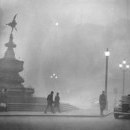Mystery of London's killer fog: Researchers reveal how chemicals combined to form haze that killed 12,000
Daily Mail
Tue November 15, 2016
Area: London
In 1952, a mysterious fog swept through London, blanketing the city in a dense layer of pollutants that killed thousands of people and animals and made it difficult to breathe for days.
While the exact cause has long remained unknown, an international team of researchers now says its solved the mystery - and the same air chemistry can be seen today in China and other areas.
In a new analysis, the researchers have pinpointed the chemical processes that combined with natural fog as a result of coal burning, eventually creating a deadly acidic haze that turned the sky completely dark.
When the fog first rolled through in December of 1952, residents took little notice; fogs have long enveloped the city.
But in the days to follow, visibility was reduced to just three feet in some areas, transportation was shut down, and thousands of people suffered from breathing problems.
After the devastating event, it was thought that at least 4,000 people had died, along with thousands of animals, and more than 150,000 people were hospitalized.
Later studies, however, estimate that the death count may actually have exceeded 12,000.
Now, using data from modern pollution in China, researchers have determined that the catastrophic event was the result of sulfuric acid particles mixing with natural fog to cover the entire city.
'People have known that sulfate was a big contributor to the fog, and sulfuric acid particles were formed from sulfur dioxide released by coal burning for residential use and power plants, and other means," says Renyi Zhang, University Distinguished Professor and the Harold J. Haynes Chair of Atmospheric Sciences and Professor of Chemistry at Texas A&M University.
'But how sulfur dioxide was turned into sulfuric acid was unclear.
'Our results showed that this process was facilitated by nitrogen dioxide, another co-product of coal burning, and occurred initially on natural fog.
'Another key aspect in the conversion of sulfur dioxide to sulfate is that it produces acidic particles, which subsequently inhibits this process.
'Natural fog contained larger particles of several tens of micrometers in size, and the acid formed was sufficiently diluted.
'Evaporation of those fog particles, then left smaller acidic haze particles that covered the city."
According to the researcher, a similar chemistry frequently occurs in modern China, which hosts 16 of the world"s most polluted cities.
But, China"s pollution problem is not exactly the same.
The country has experienced massive industrial and manufacturing growth over the past few decades, and the emissions largely come from power plants, automobiles, and fertilizers.
'The difference in China is that the haze starts from much smaller nanoparticles, and the sulfate formation process is only possible with ammonia to neutralize the particles," Zhang said.
'In China, sulfur dioxide is mainly emitted by power plants, nitrogen dioxide is from power plants and automobiles, and ammonia comes from fertilizer use and automobiles.
'Again, the right chemical processes have to interplay for the deadly haze to occur in China. Interestingly, while the London fog was highly acidic, contemporary Chinese haze is basically neutral."
The 1952 event is considered to be the deadliest air pollution event in European history, and spurred the passage of the Clean Air Act in 1956 by British Parliament.
And, while China has been making attempts in recent years to cut back on its emissions, the researchers note that the poor air quality still often necessitates breathing masks during much of the day.
By solving the mystery of the London fog, they say they may also have uncovered insight that could help in China.
'A better understanding of the air chemistry holds the key for development of effective regulatory actions in China," Zhang said.
'The government has pledged to do all it can to reduce emissions going forward, but it will take time.
'We think we have helped solve the 1952 London fog mystery and also have given China some ideas of how to improve its air quality.
'Reduction in emissions for nitrogen oxides and ammonia is likely effective in disrupting this sulfate formation process."





 Share your thoughts in the Forum
Share your thoughts in the Forum
